Controverscial.Com
![]()
Welcome
![]()
|
Controverscial.Com
Welcome
|
|
|
Controverscial.Com
Welcome
|



![]()
In the earliest days of mans evolution, the Paleolithic
or
Old Stone Age, man was a hunter-gatherer.
He hunted small animals and birds, fished and collected wild fruit, nuts
and berries for his subsistence. His
first tools and weapons were simple and crude, sticks and stones picked up off the ground.
Later man learned to improve these tools using one stone to hammer away
at another sharpening the sides and ends of the stone.
These could then be used to cut meat, carve wood and dig for roots. These early stone tools were mainly handheld tools, later
they learned to sharpen both sides of the stone and attach them to wooden
handles, creating spear shafts and arrows and greatly improving their uses.
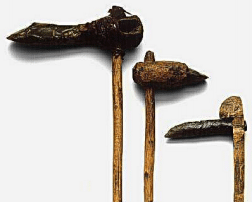
The adzes (left and centre) were used
for shaping wood and the sickle (right) was used in harvesting during the late
Stone Age.
Perhaps the most significant discovery during this
early evolution of man was the use and control of Fire.
To prehistoric man fire would have been a frightening spectacle, produced
by awe inspiring mystical events such as volcano eruptions and lightening
striking trees. Fire must have seemed more threatening than comforting, but
conquering fear, they dared to approach the embers of a fire kindled by nature
and learned to preserve it in the shelter of their stone caves.
They discovered that fire could cook food, sharpen wooden tools, light
their way by night and frighten off wild animals and predators.
They later learned to build their own fires by striking sparks from stone
(Flint) or rubbing two sticks together causing friction.
Throughout the Stone Age, vast changes occurred in climate and other conditions affecting mankind’s evolution. The Stone Age was thus divided into three periods: the Paleolithic, Mesolithic and Neolithic periods. The Paleolithic, or Old Stone Age was the longest. It began about 2 million years ago when stone tools were first used for hunting and gathering food. Overtime a variety of stone tools were made for specific purposes, including bone tools. By the end of the Paleolithic period, modern humans (Homo sapiens) had started making such specialized tools as needles and harpoons. In the caves of Europe, such as the Cro-Magnon in France, wall paintings show evidence of both religious cults and social integration that point to the complexity of their developing cultures.
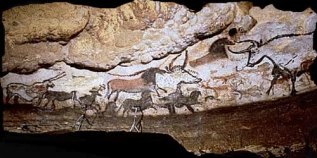
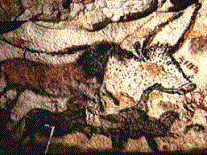
Cave paintings of the Cro-Magnon at Lascaux in France
After 13,000 BC toward the end of the Paleolithic period, more clement weather patterns resulted in the greater availability of food. In tropical and temperate forest regions, Paleolithic tools were adapted to the new conditions. By the Mesolithic, or Middle Stone Age (8000-4000 BC), peoples of both the Middle East and Mesoamerica begun to develop into agricultural villages where stone tools became highly polished and varied. In the Neolithic period, or New Stone Age (4000-2000 BC) pottery appeared in the ancient Middle East and metals such as Iron and Copper were being discovered and used for the first time. New discoveries brought societies together creating sophisticated cultures. They built cities, invented forms of writing and created complex social structures with class systems and religious beliefs.
Given
mans early reliance on stone, little wonder then that stone would evolve
as one of mans earliest symbols of reverence and worship.
Initially stone was worshiped as a manifestation of God himself, usually
inspired with awe because of it’s size, shape and colour.
The pre-biblical Semitic cultures are believed to have possessed stone
worshipping cults, as did tribes in parts of pre-Hellenic Greece, Crete,
Thessaly, Africa and India. As
cultures became more sophisticated, stone ceased to be regarded as God himself,
but instead became the abode of God whose powers, spirit and attributes became
infused in stone.
This belief of God, or the spirit of God in stone occurred among the tribes of the North America Indians, and equally among the aboriginal tribes of Australia, to whom the vestige of a large rock or boulder on the empty space of the prairie or desert would have seem especially awesome. In the myths of these tribes these huge boulders were thought to be the dwelling place of special Gods or Ancestral Spirits who had not quite made the transition from ‘God as Stone’ to ‘God in Stone’. A prime example is Ayers Rock situated in the Uluru National Park, Northern Territories of Australia.
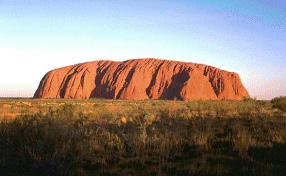
Ayers Rock, Uluru National Park,
Australia.
Later Megalithic monuments, large roughly dressed stones standing alone or combined to form a structure were erected for religious purposes or as burial places. Found in all parts of the world, those in Western Europe date from the Neolithic and Bronze Age era, while those of India date from the first centuries of the Christian era. Areas with the greatest concentration of megalithic monuments include: the British Isles, France, Belgium, Spain, Portugal, the islands of the western Mediterranean, Scandinavia, North Africa, the Crimea, the Caucasus, the Middle East, the Iranian uplands, Japan and Myanmar (formerly Burma), Assam and the Deccan Plateau in India, also the islands of the South Pacific Ocean, particularly Easter Island.
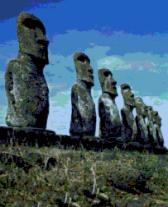
Easter
Island, Chile
The most
common European megalithic monuments include the ‘menhir or monolith’, single standing stones
often of great size, such like for
example The Five Kings in Northumberland, England,
stone circles containing many monoliths as at Stonehenge in Wiltshire, England,
and the rows of monoliths such as those at Carnac in Brittany, France.
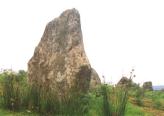
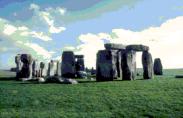
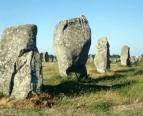
Five
Kings, England - Stonehenge, England
- Carnac, France.
Burial chambers, or chamber tombs were built and usually walled with
monoliths roofed by capstones or false vaults.
These would then be covered with earth, smaller stones, or Cairns (see
below). Chamber tombs are sometimes
called ‘dolmens’ and are the most widespread type of megalithic monuments in
Western Europe. Most of those that remain have through the ages lost their coverings, and their monoliths
exposed to the ravages of time now look like forlorn huts, such as Kits Coty in
Kent, England and Glenroan in County Tyrone, Ireland.
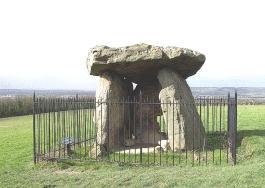
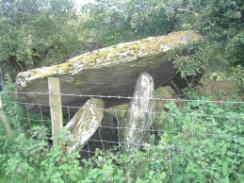
Kits Coty, Kent, England - Glenroan, County Tyrone, Ireland.
The majority of these burial chambers were originally built within earth
mounds or barrows. Common among
these are the ‘passage grave’ in which the chamber is approached by a
passage; and the ‘gallery grave’ containing a long rectangular chamber.
The interiors of the walls and roofs of some tombs were decorated with
geometric or naturalistic designs. Perhaps
the most famous example of a passage
grave is Newgrange in County Meath,
Ireland.

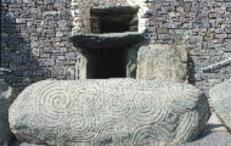
Newgrange
passage grave in County Meath, Ireland -
Entrance Stone & Roof Box.
The idea of God or the spirit and power of God in Stone, natural stone,
not sculpted stone, was a worldwide phenomenon.
The ancient Greeks and Celts devoted much of their religious beliefs to
such stones, particularly those vaguely phallic in shape, which they attributed
to the Gods of fertility. Such
stones as ‘the Pipers’, two megalithic
stones in Cornwall were venerated; and interestingly
are situated near to a stone circle called the ‘Merry Maidens’, perhaps
showing how much importance our ancestors place on the gods of fertility.
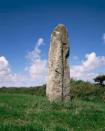

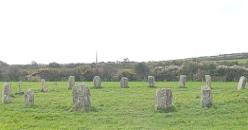
Piper
1 -
Piper 2 -
The Merry Maidens near Penzance in Cornwall.
The Greeks also erected Cairns, heaps of stones, which they
ascribed to the god Hermes ‘the god of travellers’. These they placed at holy places, crossroads and boundaries,
where travellers could add a stone and partition the gods for a safe journey.
This practice was common throughout the Celtic regions of Europe,
including Britain, the Middle East and Asia, as well as the aboriginal tribes of
Australia. The Celts placed many of their Cairns on mountain peaks and
summits dedicated to the mountain gods, believing that by adding a stone it
would magically wipe away a traveller’s weariness. Hikers and mountain climbers still continue the practice
today, but more as a pleasant tradition rather than a piece of magic or worship.
Cairns was also used to cover burial chambers (see above), and some fine examples can be found in the Kilmartin Valley of Argyll in Scotland. The ‘Nether Largie Cairns’ are part of a linear progression of Cairns that appear in a North-South direction. The North cairn is a fairly large circle with one burial chamber. The Middle cairn is about 100 feet in diameter with a burial chamber in the centre, and the South cairn, the oldest burial site in the line is a round cairn constructed in the Neolithic period.
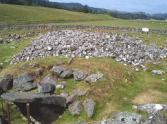
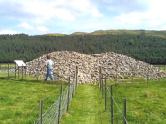
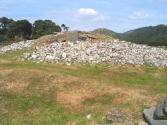
North Cairn
- Middle Cairn
- South Cairn
Stones with natural holes (a female symbol) were also given prominence, as much so as the phallic kind. Barren women would be passed through the hole of larger specimen stones, to undertake the magical and curative powers of a symbolic birth or re-birth. Smaller stones with natural holes were worn as amulets, on pendants or as necklaces by women around the world to facilitate fertility. They were also hung over the beds of a woman in labour and over the doorway to fend away witches.
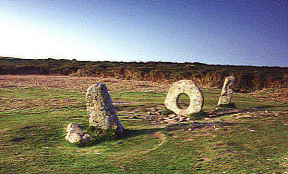
Men-An-Tol in
Cornwall, England
The concepts of god-as-stone and god-in-stone developed
into the belief that stones with natural holes and other stones with unusual
features were sacred stones because of their mystical association with divine
powers. Down through the ages many
other stones were thought to have gained their own inherent powers, and many
legends are told of their use in religious ceremonies, ritual and magic.
In Greece “The Omphalos” is a decorated stone covered with sculpted engravings of Honeybees. It was used as a symbol indicating that Delphi in Greece was the centre of the world. According to myth, Zeus let free two eagles from the deepest corners of the universe in order to find the centre of the earth. As they circled the earth from different directions, they flew towards each other and met at Delphi, ‘the navel of the world’ (omphalos in Greek means navel). Another myth has it that the Omphalos was the tomb of a dragon Python, known as the Son of Gaia, who was killed by the god Apollo in order to get possession of the Oracle.
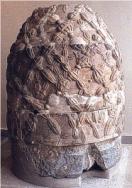
The
Omphalos
In Saudi Arabia, the “Black Stone of Islam” is one of the cornerstones
of the Kaaba, the ancient stone building towards which all Muslims pray.
The Black Stone was declared by the prophet Muhammad to have been given
to Abraham by the archangel Gabriel, and is revered the world over by Muslims. The Kaaba is located in Mecca, Saudi Arabia where it is
surrounded by the enormous Grand Mosque called Masjid al-Haram.
The stone itself is comparatively small, being roughly 50 cm (19.7 in.)
in diameter, however it can be instantly recognized by the large silver band
that holds it all together. The
Stone was actually broken into several pieces when Ismaili warriors sacked Mecca
in 930, and carried the Black Stone away. It
was returned twenty-two years later and is now held together by the silver band,
which is fastened by silver nails into the NE corner of the Kaaba.
When pilgrims circle the Kaaba as part of the ritual of the Hajj, many of
them stop and kiss the Black Stone.
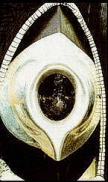
The Black Stone of Islam
In England the Stone of Scone
(pronounced 'scoon') also known as the Stone of Destiny or the Coronation Stone,
is a block of sandstone that was historically kept at the now-ruined abbey in
Scone, near Perth in Scotland. It
was used for centuries as a seat at the coronation of the Kings and Queens of
Scotland, and later the Kings and Queens of England.
Mythologically, it was thought to have been a stone pillow used by the
Biblical Jacob, and in another legend it was the travelling altar used by St
Columba during his missionary activities throughout Scotland.
In still another legend it was the Coronation Stone of the early Irish
Gaels, which they brought with them when invading Caledonia.
Since the time of Kenneth
MacAlpine, King of Dalriada and the
first King of Scots at around 847, Scottish monarchs were seated on the stone
during their coronation ceremony.
In 1296 after
invading and conquering Scotland, Edward I declared
himself King of that realm and Stone
of Scone was removed to Westminster Abbey in London, England.
There it was fitted into a wodden throne known as St. Edward's Chair, and
used at the coronations of the future Kings and Queens of England.
On Christmas Day 1950, the stone was stolen from Westminster Abbey by a
group of Scottish students intent on returning it to Scotland, but it
was recovered four months later and returned Westminster
Abbey.
In 1996 the British Government decided that the Stone should be kept in Scotland when not in use at coronations, and on St Andrews Day the 30th of November 1996, the Stone of Scone was returned to it’s natural heritage home of Scotland and placed in Edinburgh Castle. It now remains protected behind sophisticated security systems and armoured glass. The stone will continue to be use at future coronations and will be transport back to Westminster Abbey when it is required for that occasion.
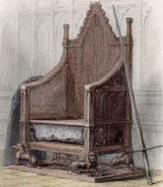
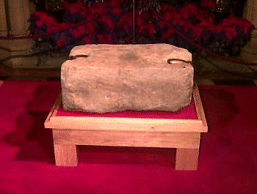
St.
Edward's Chair ‘circa 1855’ -
The Stone of Scone today
In more modern times singular sculpted stones are used commonly as gravestones. The idea of erecting a tombstone over a grave comes from the ancient belief that after death a person’s soul or spirit will inhabit the stone. What is now a memorial, in ancient times was a person’s spiritual abode.
From the earliest Paleolithic times of Stone Age man, all the way down to our present technological age, people of all cultures have found beauty, power and mystery in stones. In ancient times precious and semi-precious stones were selected for their symbolic value based on colour, shape and durability. Properties were accorded through their natural elemental brilliance associated with nature i.e. the richly glowing greens of Emeralds with Earth, the sparkling sunshine yellows of Citrine with Air, the intense flaming reds of Ruby with Fire and the cool clear blues of Aquamarine with Water.
In
ancient times precious and semi-precious stones were found lying on the ground
exposed to the sun and stars, washed down from mountains high by rain torrents,
floods and rivers. They were also
found buried in the ground when digging for roots, dull, prismatic, dense and
coarse, but representing all shades and colours of the rainbow. Early man sensed a force and power trapped within these
stones, and they became the gifts of the earth, manifestations of universal
forces and representative of Deity that created the all, the all that was, and
all that has the potential of being.
Over
time as cultures became more sophisticated, stones basic associations with
nature were expanded into more complex schemes of occult correspondences,
elaborated by priests, magicians, wizards and sages.
Even common stones because of their colour and brilliance became endowed
with celestial values that exalted them to veritable jewels.
Stones in their
natural state were often used by early man, shaped and worn as attractive,
practical and decorative adornments, buttons to fasten clothing etc.
Later, as their intrinsic values and associations appreciated, they were
worn and fashioned into Amulets, Talismans and Charms.
Amulets
are protective and were used for protection against illness and disease,
physical dangers such like lightning and storms at sea, but more particularly
they were worn to fend off demons and the evil eye of Witches.
Talismans on the other hand are attractive, and were used to attract
such things as fertility, wealth, luck and success. A charm is generally an amulet, though the term is often used
indiscriminately to describe both amulets and talismans.
As gemstones increased in value, so were they
were mounted into crowns, pendants and badges, as emblems symbolic of the
wearer’s social, religious or official rank.
Studded with gems of glistening fire, shining water, sparkling air and
richly glowing earth, these adornments have been worn throughout history
by Prophet, Priests, Kings and Queens. Gems
for such adornments were often chosen for their rarity, symbolic and intrinsic
value, such like Diamond for its sparkling brilliance and unyielding durability,
Pearl for purity, Topaz for nobility and regal splendour, and the flaming Ruby
for the administration of justice.
Perhaps
one of the most famous early examples of gemstones in use for religious purposes
is the story of Aaron’s Breastplate:
"And Aaron shall bear the names of the children of
Israel in the breastplate of judgment upon his heart when he goeth in unto the
holy place for a memorial before the Lord continually"
(Exodus 28.29).
Aaron was the first high priest of the Jewish people, a
brother of Moses. His breastplate
is said to have been made "for glory and for beauty", and made
according to a design given to Moses by God.
On the breastplate four rows of precious stones were set, three in each
row, each of which was engraved with the names of the twelve tribes of Israel.
According to the bible, the responsibilities of the High
Priest required a sanctified person to be dressed in "holy garments"
(Exodus 29). In addition to
the usual garments of the priestly class, the high priest wore the ephod (or
mantle, an upper garment), a breastplate and a headdress.
The ephod was a sleeveless robe of purple the lower hem of which had a
fringe of small golden bells alternating with pomegranate tassels in red,
scarlet, purple and violet. Most
important was the breastplate, which was square in outline and served as a pouch
in which the divinatory devices of the Urim and Thummim were kept.
Exodus, chapter 28, verse 15, specifies that it was to be woven of golden
and linen threads dyed blue, purple and scarlet.
Because of its oracular function it was called the “Breastpiece of
Judgment.”
The bible states:
"And thou shalt set in it settings of stones, even
four rows of stones: the first row
shall be a sardius, a topaz, and a carbuncle: this shall be the first row.
And the second row shall be an emerald, a sapphire, and
a diamond. And the third row a
ligure, an agate, and an amethyst. And
the fourth row a beryl, and an onyx, and a jasper; they shall be set in gold in
their enclosings.
And the stones shall be with the names of the children
of Israel, twelve, according to their names, like the engravings on a signet;
every one with his name shall they be according to the twelve tribes....”
The Urim and Thummim are thought to have been two sacred crystal stones, which when held up by the High Priest while standing in front of the holy alter, reflected light from the alter candles onto the breastplate. As the light from the alter candle reflected through the Urim and the Thummin onto the 12 stones of the Breastplate, this provided up to 24 combinations (2 x 12). Since there are 22 letters in the Hebrew alphabet, the flashes of light could produce strings of letters. It was said that God breathed through the wind, permitting a breeze to flicker the flame of the candle, which momentarily altered the angle of the light from the Urim and Thummin onto the Breastplate. Thus was God able to communicate directly to the high priest with his pronouncements.
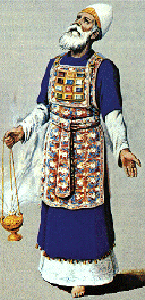
Dress of the High Priest wearing Aaron’s Breastplate
When we mention gemstones, perhaps the first and most
sought after stone is the diamond. Indeed
some of the most famous diamonds have a tragic and chequered history.
The Hope Diamond for instance is a sapphire-blue gemstone originally from
India, and is one of the largest blue diamonds ever known.
Legend has it that it once
adorned a statue of the Hindu goddess Sita, wife of Rama. It was stolen by a Brahman priest and the curse of the
angered goddess has been visited upon its owners ever since.
Through out its
300-year history, the owners of the Hope Diamond have suffered a series of
tragic and mysterious circumstances. They
include Marie Antoinette; a British heir to the stone who died in bankruptcy; a
French ‘Folies Bergère’ star slain by a jealous lover; a Greek broker who
drove off a cliff with his wife and children; and an American millionairess
whose husband and two of four children died in tragic circumstances.
The Hope diamond was thought to have been cut from a
112-carat stone brought to France by the jewel trader Jean-Baptiste Tavernier,
and purchased by Louis XIV in 1668 as part of the French crown jewels.
The stone, later called the French Blue, was re-cut into a 67-carat heart
in 1673. In
1792, a revolutionary mob stormed across Paris and Louis XVI and Marie
Antoinette were imprisoned; the thieves scaled the colonnades of the Garde Meuble,
broke into the glass case containing the French Crown Jewels, and made off with
its contents. The 45.5-carat
Hope diamond, re-named for the London banker Thomas Hope who purchased it in
1830, was apparently cut from the French Blue, and is now on display in the
Smithsonian Institution in Washington, D.C.
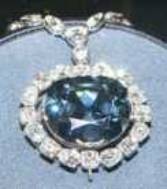
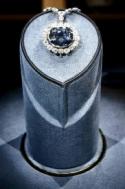
The Hope Diamond on display in the
Smithsonian Institution, Washington, D.C.
Another equally
famous diamond is the Koh-i-Noor, whose history includes centuries of romantic
lore. The Koh-i-Noor is a large
diamond first reported in 1304 to be in the possession of the Raja of Malwa.
It later fell into the hands of Baber, who founded the Mogul dynasty in
1526. For the next two centuries it
was considered the diamond jewel among jewels in the treasury of the Mogul
emperors.
In 1739 Nadir Shah
of Persia invaded India, looted the Mogul palace and rummaged through the
capital city of Delhi for 58 days, looking for among other things, the famous
diamond. A harem woman told him
that the emperor had hidden it in his turban. The conqueror thereupon invited the conquered to a feast and
offered to exchange turbans as a sign of amity. The emperor, having to make a fast choice between his head
and his diamond, doffed his turban. Nadir
Shah in the privacy of his tent, unrolled the turban and found the brilliant gem
and exclaimed: “Koh-i-Noor!”
the ”Mountain of Light!”
Nadir Shah was
assassinated in 1747, and it is said that his son died by torture rather than
give up the priceless gem he had inherited.
Eventually though, it passed to other rulers with other armies, first to
the Afghans, then to the Sikhs and finally to the British, who found it in the
treasury at Lahore, the Punjab capital in 1849. Two officers took it off to
London to present it to Queen Victoria.
The British found
it rather dull. In an attempt to
give it greater brilliance, the queen had it re-cut from its original 186 carats
to 108.93 carats, at a cost of $40,000, and almost everyone was displeased with
the result. Victoria wore the huge
diamond as a personal ornament. She
willed it to her daughter-in-law, Queen Alexandra who wore it at the coronation
of Edward VII.
In 1911 the Koh-i-Noor was placed in the crown of Queen Mary. Twenty-six years later, Elizabeth the consort of King George VI, had a crown made to wear at her husband's coronation. It is now known as the Queen Mother's Crown, one of nine British crowns, and from it flashes the Koh-i-noor. Today it is one of the most popular treasures displayed in the Tower of London.
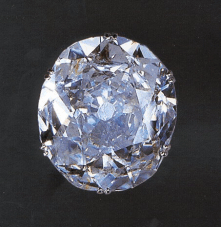
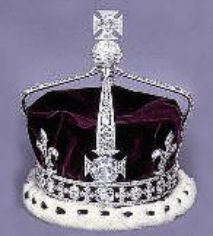
The Koh-i-Noor
diamond was fitted into the Queen
Mother's Crown .
In folklore stones have been used for many purposes, even
such stones as plain ordinary pebbles. Pebbles
collected off a beach were often used to cure warts.
Take as many pebbles as you have warts, spit on them and rub them onto
the warts (or prick the warts and smear the blood on the pebbles), then throw
the pebbles over your left shoulder and walk away without looking back, the
warts will then fade away. This cure is also said to work on freckles.
Another belief was that to trip over a stone was unlucky unless you
return and touch it. Likewise an
old Hawaiian tale tells of a man who kicked a stone that was unknown to him
sacred to a god. His sleep
thereafter was plagued with dreams of being stoned to death, and only stopped
when he went back and replaced the stone to its original place.
As a legacy, the chipped-flint tools, axes and arrowheads,
used by our stone-age ancestors, are now being found throughout Europe and the
rest of the world. What were once
of practical use, have now been given mythological status.
To some they are thought to have dropped from the sky, or were hurled by
the gods as thunderbolts associated with Zeus or Jupiter.
In Ireland, they are associated with the Fairies, the arrowheads known as
fairy bolts.
Today many stones are accorded special significance for their healing, magical and divination properties. My soul mate in America “Patricia J. Martin” has compiled a brilliant series of articles on individual stone correspondences, for more see:
To be added.

Let there be peace in the world - Where have all the flowers gone?
My Personal Page / My Place in England, UK / My Family Tree (Ancestry)
Wicca/Witchcraft / What is Wicca / What is Magick
Traditional Writings:
Wiccan Rede / Charge of the Goddess / Charge of the God / The Three-Fold Law (includes The Law of Power and The Four Powers of the Magus) / The Witches Chant / The Witches Creed / Descent of the Goddess / Drawing Down the Moon / The Great Rite Invocation / Invocation of the Horned God / The 13 Principles of Wiccan Belief / The Witches Rede of Chivalry / A Pledge to Pagan Spirituality
Correspondence Tables:
Incense / Candles / Colours / Magickal Days / Stones and Gems / Elements and Elementals
Traditions Part 1 - Alexandrian Wicca / Aquarian Tabernacle Church (ATC) / Ár Ndraíocht Féin (ADF) / Blue Star Wicca / British Traditional (Druidic Witchcraft) / Celtic Wicca / Ceremonial Magic / Chaos Magic / Church and School of Wicca / Circle Sanctuary / Covenant of the Goddess (COG) / Covenant of Unitarian Universalist Pagans (CUUPS) / Cyber Wicca / Dianic Wicca / Eclectic Wicca / Feri Wicca /
Traditions Part 2 - Gardnerian Wicca / Georgian Tradition / Henge of Keltria / Hereditary Witchcraft / Hermetic Order of the Golden Dawn (H.O.G.D.) / Kitchen Witch (Hedge Witch) / Minoan Brotherhood and Minoan Sisterhood Tradition / Nordic Paganism / Pagan Federation / Pectic-Wita / Seax-Wica / Shamanism / Solitary / Strega / Sylvan Tradition / Vodoun or Voodoo / Witches League of Public Awareness (WLPA) /
Gods and Goddesses (Greek
Mythology) / Esbats &
Full Moons / Links
to Personal Friends & Resources / Wicca/Witchcraft
Resources / What's a spell? /
Circle Casting and
Sacred Space / Pentagram
- Pentacle / Marks
of a Witch / The Witches
Power / The Witches Hat
/ An
esoteric guide to visiting London / Satanism
/ Pow-wow
/ The
Unitarian Universalist Association / Numerology: Part 1
/ Part 2 / Part
3 / A
history of the Malleus Maleficarum: includes: Pope
Innocent VIII /
The
papal Bull /
The
Malleus Maleficarum /
An extract from the Malleus Maleficarum
/ The letter of approbation
/ Johann
Nider’s Formicarius /
Jacob
Sprenger /
Heinrich Kramer /
Stefano Infessura
/ Montague Summers /
The Waldenses
/ The Albigenses
/
The Hussites / The
Sun Dance
/ Shielding (Occult
and Psychic Protection) /
Sabbats in History and Mythology / Samhain (October 31st) / Yule (December 21st) / Imbolc (February 2nd) / Ostara (March 21st) / Beltane (April 30th) / Litha (June 21st) / Lughnasadh (August 1st) / Mabon (September 21st)
Rituals contributed by Crone: Samhain / Yule / Imbolc / Ostara / Beltane / Litha / Lammas / Mabon
Tools of a Witch / The Besom (Broom) / Poppets and Dolls / Pendulums / Cauldron Magick / Mirror Gazing
Animals in Witchcraft (The Witches Familiar) / Antelope / Bats / Crow / Fox / Frog and Toads / Goat / Honeybee / Kangaroo / Lion / Owl / Phoenix / Rabbits and Hares / Raven / Robin Redbreast / Sheep / Spider / Squirrel / Swans / Wild Boar / Wolf / Serpent / Pig / Stag / Horse / Mouse / Cat
In Worship of Trees - Myths, Lore and the Celtic Tree Calendar. For descriptions and correspondences of the thirteen sacred trees of Wicca/Witchcraft see the following: Birch / Rowan / Ash / Alder / Willow / Hawthorn / Oak / Holly / Hazel / Vine / Ivy / Reed / Elder. Also see: The Willow Tree (Folk Music)
Mystical Sacred Sites - Stonehenge / Glastonbury Tor / Malta - The Hypogeum of Hal Saflieni / Avebury / Cerne Abbas - The Chalk Giant / Ireland - Newgrange /
Rocks and Stones:
Stones - History, Myths and Lore
Articles contributed by Patricia Jean Martin: / Apophyllite / Amber / Amethyst / Aquamarine / Aragonite / Aventurine / Black Tourmaline / Bloodstone / Calcite / Carnelian / Celestite / Citrine / Chrysanthemum Stone / Diamond / Emerald / Fluorite / Garnet / Hematite / Herkimer Diamond / Labradorite / Lapis Lazuli / Malachite / Moonstone / Obsidian / Opal / Pyrite / Quartz (Rock Crystal) / Rose Quartz / Ruby / Selenite / Seraphinite / Silver and Gold / Smoky Quartz / Sodalite / Sunstone / Thunderegg / Tree Agate / Zebra Marble
Wisdom:
Knowledge vs Wisdom by Ardriana Cahill / I Talk to the Trees / Awakening / The Witch in You / A Tale of the Woods
Articles and Stories about Witchcraft:
Murder by Witchcraft / The Fairy Witch of Clonmel / A Battleship, U-boat, and a Witch / The Troll-Tear (A story for Children) / Goody Hawkins - The Wise Goodwife / The Story of Jack-O-Lantern / The Murder of the Hammersmith Ghost / Josephine Gray (The Infamous Black Widow) / The Two Brothers - Light and Dark
Old Masters of Academia:
Pliny the Elder / Hesiod / Pythagoras
Abramelin the Mage / Agrippa / Aidan A. Kelly / Albertus Magnus “Albert the Great” / Aleister Crowley “The Great Beast” / Alex Sanders "the King of the Witches” / Alison Harlow / Amber K / Anna Franklin / Anodea Judith / Anton Szandor LaVey / Arnold Crowther / Arthur Edward Waite / Austin Osman Spare / Biddy Early / Bridget Cleary / Carl Llewellyn Weschcke / Cecil Hugh Williamson / Charles Godfrey Leland / Charles Walton / Christina Oakley Harrington / Damh the Bard (Dave Smith) / Dion Fortune / Dolores Aschroft-Nowicki / Dorothy Morrison / Doreen Valiente / Edward Fitch / Eleanor Ray Bone “Matriarch of British Witchcraft” / Dr. John Dee and Edward Kelly / Dr. Leo Louis Martello / Eliphas Levi / Ernest Thompson Seton / Ernest Westlake and the Order of Woodcraft Chivalry / Fiona Horne / Friedrich von Spee / Francis Barrett / Gerald B. Gardner / Gavin and Yvonne Frost and the School and Church of Wicca / Gwydion Pendderwen / Hans Holzer / Helen Duncan / Herman Slater "Horrible Herman" / Israel Regardie / James "Cunning" Murrell / Janet Farrar & Gavin Bone / Jessie Wicker Bell “Lady Sheba” / John Belham-Payne / John George Hohman / John Gerard / John Gordon Hargrave (the White Fox) / John Michael Greer / John Score / Johannes Junius the Burgomaster of Bamberg / Joseph John Campbell / Karl von Eckartshausen / Laurie Cabot "the Official Witch of Salem" / Lewis Spence / Margaret Alice Murray / Margot Adler / Marie Laveau the " Voodoo Queen of New Orleans" / Marion Weinstein / Matthew Hopkins “The Witch-Finder General” / Max Ehrmann and the Desiderata / Monique Wilson the “Queen of the Witches” / Montague Summers / Nicholas Culpeper / Nicholas Remy / M. R. Sellers / Mrs. Grieve "A Modern Herbal" / Oberon and Morning Glory Zell-Ravenheart / Old Dorothy Clutterbuck / Old George Pickingill / Paddy Slade / Pamela Colman-Smith / Paracelsus / Patricia Crowther / Patricia Monaghan / Patricia “Trish” Telesco / Philip Emmons Isaac Bonewits / Philip Heselton / Raymond Buckland / Reginald Scot / Robert Cochrane / Robert ‘von Ranke’ Graves and "The White Goddess" /
Rudolf Steiner / Rosaleen Norton “The Witch of Kings Cross” / Ross Nichols and The Order of Bards, Ovates & Druids / Sabrina - The Ink Witch / Scott Cunningham / Selena Fox / Silver Ravenwolf / Sir Francis Dashwood / Sir James George Frazer / S.L. MacGregor Mathers and the “Hermetic Order of the Golden Dawn” / Starhawk / Stewart Farrar / Sybil Leek / Ted Andrews / The Mather Family - includes: Richard Mather, Increase Mather, Cotton Mather / Thomas Ady / Vera Chapman / Victor Henry Anderson / Vivianne Crowley / Walter Brown Gibson / William Butler Yeats / Zsuzsanna Budapest
Many of the above biographies are brief and far from complete. If you know about any of these individuals and can help with aditional information, please cantact me privately at my email address below. Many thanks for reading :-)
While I have taken due care and dilligence to credit all sources where possible, this website may contain copyrighted material which has not been specifically authorized by the copyright owner. My use of making such material available here is done so in my efforts to advance our understanding of religious discrimination, the environmental and social justice issues etc. If you wish to use copyrighted material from this wedsite for purposes of your own then you must obtain permission from the relevant copyright owner yourself.
![]()
My online email discussion group:
http://groups.yahoo.com/group/Email_Witches

Help send a message of peace around the world! The Dove of Peace flies from site to site, through as many countries as possible. It does not belong to ANY belief system. Please help make a line around the globe by taking it with you to your site, by giving it to someone for their site, by passing it on to another continent or to the conflict areas of the world. May trouble and strife be vanquished in it's path.

mailto:George@controverscial.com
![]()
|
|